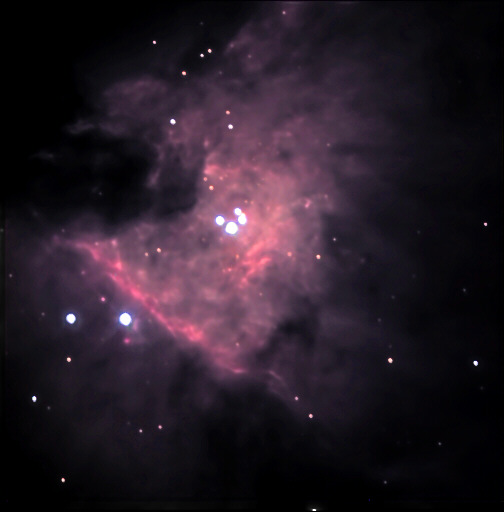
Image taken with an SBIG ST-9E CCD camera thru Kopernik's
20-inch F/8.1 telescope. This image was made from ten 30 second exposures
using an H-alpha filter, plus ten 2.5 second exposures each thru Red, Green,
and Blue filters.

Image taken with an SBIG ST-9E CCD camera thru Kopernik's
20-inch F/8.1 telescope. This image was made from ten 30 second exposures
using an H-alpha filter, plus ten 2.5 second exposures each thru Red, Green,
and Blue filters.
Theta Orionis is the noted quadruple,
or multiple star, in the heart of the the Great
Orion Nebula (M-42). This very young group provides the "power
source" which lights up the nebula. It is known as "The Trapezium".
(For more on the Trapezium see M-43).
Quote from Burnham's Celestial Handbook:
"This is probably the best known multiple star in the sky, and one of the most interesting for the small telescope. The four brighter components form a little quadrangle called the "Trapezium" and the object is a favorite of all observers."
"The ....... primary of the group (has) a visual magnitude of about 5.4; the spectral type is near 06. ......The spectra of (the second & third brightest stars) are BO and A7 respectively. The faintest star..... is an eclipsing binary with a period of 6.471 days, and is also known under its variable star designation which is "BM Orionis". (The primary star) was in 1975 identified as an eclipsing binary with a period of 65.432 days and a visual range of 6.7 to 7.7."
"The Trapezium is the bright core of a compact cluster of faint stars which may form an expanding association. Within 5' of the Trapezium are more than 300 stars brighter than 17th magnitude. A study of this group has been made by K.A.Strand; he finds some evidence for an expansion rate which would indicate an age of no more than 300,000 years, and make this one of the very youngest star clusters known."